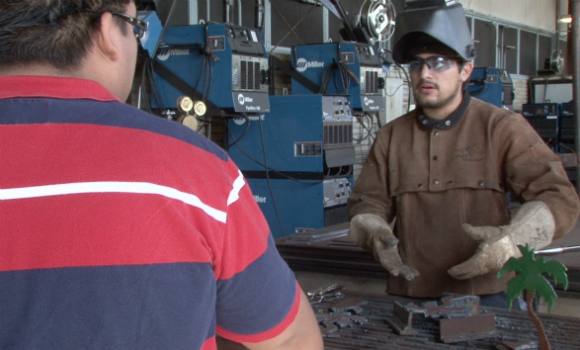
Metal cutting demonstration at Cerritos College. (Credit: John Guenther)
“There is a stigma that auto repair is dirty, it’s blue collar, you don’t make much money and you break your back,” said Mary Kemnitz, owner of D & H Enterprises in Concord and also the president of the Automotive Service Councils of California, an organization of about 1,000 independent auto repair shops statewide.
In the next decade, California may see a deficit of two million skilled workers. The stigma of certain jobs may have in part led to a shortage of auto technicians and other skilled workers in the state.
Nancy Shulock, a public policy professor at California State University of Sacramento and executive director of the Institute for Higher Education Leadership and Policy agreed. “It’s a very interesting one because the economy has changed and the people who perpetuate the stigma haven’t fully realized the opportunity to students today in many of these career and technical education fields.”
It’s a complex issue that goes all the way back to 1960. That’s when California implemented its Master Plan for Higher Education which defined roles for the University of California, the California State University System and the Community colleges. Each system has a role in promising students universal access to a baccalaureate education, or a bachelor’s degree. The Plan is credited with giving the state one of the best post-secondary educational systems in the country. But it may have also helped decrease the value of Career Technical Education (CTE) in the community college system to many people.
“The high schools will tell you that for them, it’s all about getting kids to the university level. And the colleges, counselors and staff will tell you it’s all about getting students ready to transfer (to universities),” said Shulock, which all but leaves behind CTE.
And Shulock said it gets even more complex with “the incredible power of the racial dimension, the demographics in California, the immigrant population, first-generation college students.” There is a history of racially-based tracking starting at a young age and “so many educators and advocacy groups and others have tried so hard to open up educational opportunity for everybody.”
There was another way students were being tracked that added to the stigma. “It used to be that the kids who did badly in school were always shuttled into the vocational area and sent to learn how to work on cars,” Kemnitz lamented. “So much of that has changed — the automobile is becoming so high tech that you practically need engineering to work on it.”
Justin Christensen, an automotive technology student at Cerritos College, is working toward his associate degree and will have a good-paying job at a local automotive dealership when he graduates. He’s thinking about continuing his education and pursuing his Bachelor’s in engineering. But he said he chose his current path because, “I pay less for all my general education that I need to get out of the way and then I go to a four-year and finish two years and get a degree from that school. It was economically better to go to this school.”
The stigma might be changing as state lawmakers added $50 million to the 2014-2015 state budget to help finance the high cost of CTE programs. It also adopted a new shared-funding investment model, which was called for by the Workforce Action Team of the California Economic Summit. This may help students realize that CTE is a way into good-paying, highly valued and highly technical careers in the health care, IT, automotive, energy, advanced manufacturing and logistics fields. And, it seems, there will be demand in these fields for at least the next decade.

